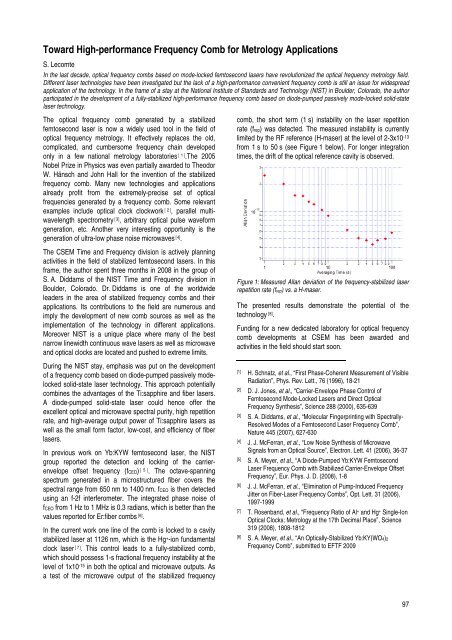CSEM Scientific and Technical Report 2008
CSEM Scientific and Technical Report 2008
CSEM Scientific and Technical Report 2008
You also want an ePaper? Increase the reach of your titles
YUMPU automatically turns print PDFs into web optimized ePapers that Google loves.
Toward High-performance Frequency Comb for Metrology Applications<br />
S. Lecomte<br />
In the last decade, optical frequency combs based on mode-locked femtosecond lasers have revolutionized the optical frequency metrology field.<br />
Different laser technologies have been investigated but the lack of a high-performance convenient frequency comb is still an issue for widespread<br />
application of the technology. In the frame of a stay at the National Institute of St<strong>and</strong>ards <strong>and</strong> Technology (NIST) in Boulder, Colorado, the author<br />
participated in the development of a fully-stabilized high-performance frequency comb based on diode-pumped passively mode-locked solid-state<br />
laser technology.<br />
The optical frequency comb generated by a stabilized<br />
femtosecond laser is now a widely used tool in the field of<br />
optical frequency metrology. It effectively replaces the old,<br />
complicated, <strong>and</strong> cumbersome frequency chain developed<br />
only in a few national metrology laboratories [ 1] .The 2005<br />
Nobel Prize in Physics was even partially awarded to Theodor<br />
W. Hänsch <strong>and</strong> John Hall for the invention of the stabilized<br />
frequency comb. Many new technologies <strong>and</strong> applications<br />
already profit from the extremely-precise set of optical<br />
frequencies generated by a frequency comb. Some relevant<br />
examples include optical clock clockwork [ 2] , parallel multiwavelength<br />
spectrometry [3] , arbitrary optical pulse waveform<br />
generation, etc. Another very interesting opportunity is the<br />
generation of ultra-low phase noise microwaves [4] .<br />
The <strong>CSEM</strong> Time <strong>and</strong> Frequency division is actively planning<br />
activities in the field of stabilized femtosecond lasers. In this<br />
frame, the author spent three months in <strong>2008</strong> in the group of<br />
S. A. Diddams of the NIST Time <strong>and</strong> Frequency division in<br />
Boulder, Colorado. Dr. Diddams is one of the worldwide<br />
leaders in the area of stabilized frequency combs <strong>and</strong> their<br />
applications. Its contributions to the field are numerous <strong>and</strong><br />
imply the development of new comb sources as well as the<br />
implementation of the technology in different applications.<br />
Moreover NIST is a unique place where many of the best<br />
narrow linewidth continuous wave lasers as well as microwave<br />
<strong>and</strong> optical clocks are located <strong>and</strong> pushed to extreme limits.<br />
During the NIST stay, emphasis was put on the development<br />
of a frequency comb based on diode-pumped passively modelocked<br />
solid-state laser technology. This approach potentially<br />
combines the advantages of the Ti:sapphire <strong>and</strong> fiber lasers.<br />
A diode-pumped solid-state laser could hence offer the<br />
excellent optical <strong>and</strong> microwave spectral purity, high repetition<br />
rate, <strong>and</strong> high-average output power of Ti:sapphire lasers as<br />
well as the small form factor, low-cost, <strong>and</strong> efficiency of fiber<br />
lasers.<br />
In previous work on Yb:KYW femtosecond laser, the NIST<br />
group reported the detection <strong>and</strong> locking of the carrierenvelope<br />
offset frequency (fCEO) [ 5] . The octave-spanning<br />
spectrum generated in a microstructured fiber covers the<br />
spectral range from 650 nm to 1400 nm. fCEO is then detected<br />
using an f-2f interferometer. The integrated phase noise of<br />
fCEO from 1 Hz to 1 MHz is 0.3 radians, which is better than the<br />
values reported for Er:fiber combs [6] .<br />
In the current work one line of the comb is locked to a cavity<br />
stabilized laser at 1126 nm, which is the Hg + -ion fundamental<br />
clock laser [ 7] . This control leads to a fully-stabilized comb,<br />
which should possess 1-s fractional frequency instability at the<br />
level of 1x10 -15 in both the optical <strong>and</strong> microwave outputs. As<br />
a test of the microwave output of the stabilized frequency<br />
comb, the short term (1 s) instability on the laser repetition<br />
rate (frep) was detected. The measured instability is currently<br />
limited by the RF reference (H-maser) at the level of 2-3x10 -13<br />
from 1 s to 50 s (see Figure 1 below). For longer integration<br />
times, the drift of the optical reference cavity is observed.<br />
Figure 1: Measured Allan deviation of the frequency-stabilized laser<br />
repetition rate (frep) vs. a H-maser.<br />
The presented results demonstrate the potential of the<br />
technology [8] .<br />
Funding for a new dedicated laboratory for optical frequency<br />
comb developments at <strong>CSEM</strong> has been awarded <strong>and</strong><br />
activities in the field should start soon.<br />
[1] H. Schnatz, et al., “First Phase-Coherent Measurement of Visible<br />
Radiation”, Phys. Rev. Lett., 76 (1996), 18-21<br />
[2] D. J. Jones, et al., “Carrier-Envelope Phase Control of<br />
Femtosecond Mode-Locked Lasers <strong>and</strong> Direct Optical<br />
Frequency Synthesis”, Science 288 (2000), 635-639<br />
[3] S. A. Diddams, et al., “Molecular Fingerprinting with Spectrally-<br />
Resolved Modes of a Femtosecond Laser Frequency Comb”,<br />
Nature 445 (2007), 627-630<br />
[4] J. J. McFerran, et al., “Low Noise Synthesis of Microwave<br />
Signals from an Optical Source”, Electron. Lett. 41 (2006), 36-37<br />
[5] S. A. Meyer, et al., “A Diode-Pumped Yb:KYW Femtosecond<br />
Laser Frequency Comb with Stabilized Carrier-Envelope Offset<br />
Frequency”, Eur. Phys. J. D. (<strong>2008</strong>), 1-8<br />
[6] J. J. McFerran, et al., “Elimination of Pump-Induced Frequency<br />
Jitter on Fiber-Laser Frequency Combs”, Opt. Lett. 31 (2006),<br />
1997-1999<br />
[7] T. Rosenb<strong>and</strong>, et al., “Frequency Ratio of Al + <strong>and</strong> Hg + Single-Ion<br />
Optical Clocks; Metrology at the 17th Decimal Place”, Science<br />
319 (<strong>2008</strong>), 1808-1812<br />
[8] S. A. Meyer, et al., “An Optically-Stabilized Yb:KY(WO4)2<br />
Frequency Comb”, submitted to EFTF 2009<br />
97








